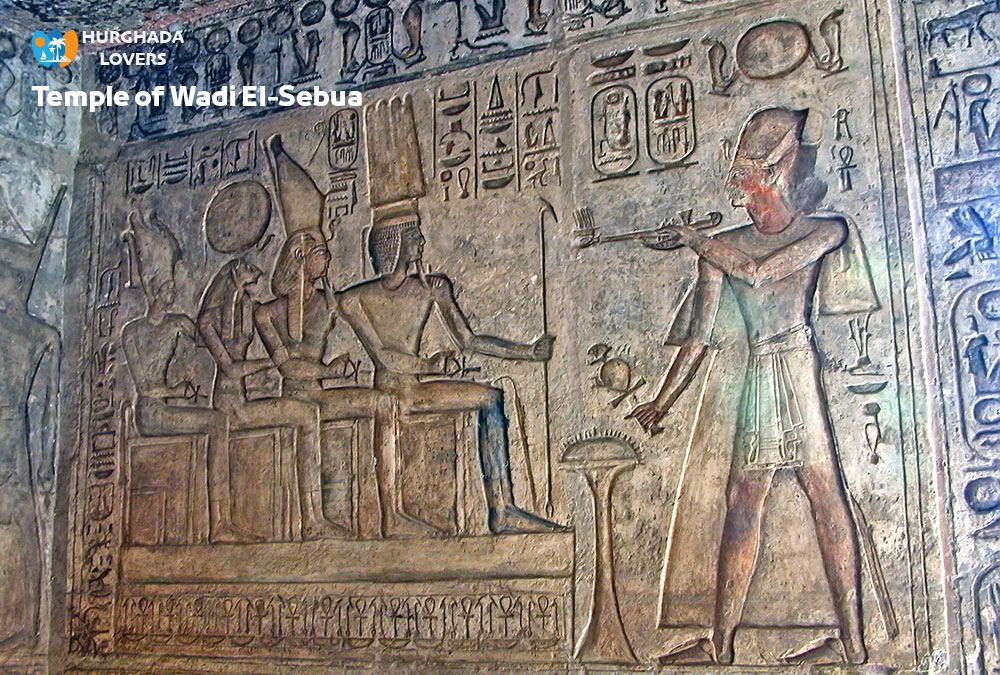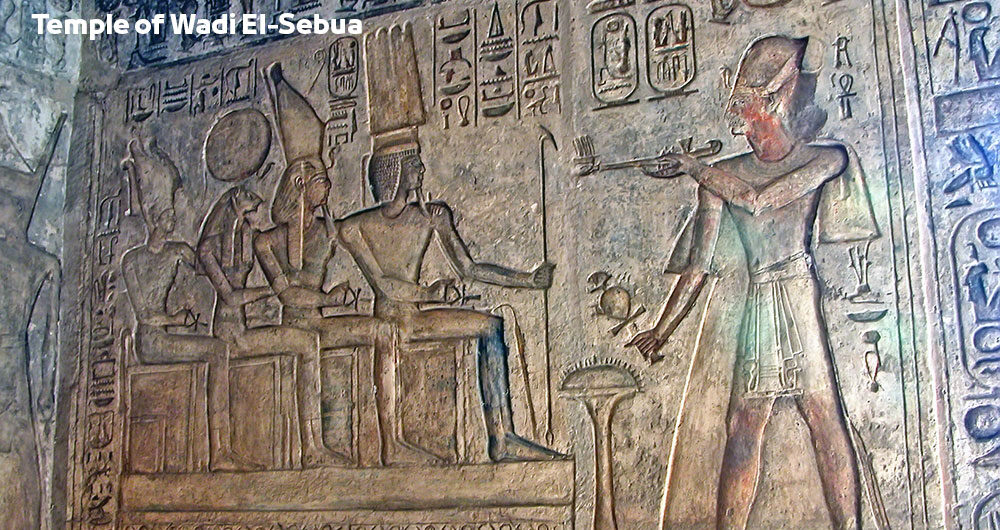Temple of Wadi El-Sebua in Nubia, Aswan, Egypt | Facts Temples Of Wadi Es-Sebua , History, Map and more about Lake Nasser Attractions.
The facts and history of building the temples of the Black Valley, the largest archaeological pharaonic temples in southern Egypt, and the secrets of the ancient civilization of Egypt, the Pharaohs, and more.
Wadi Al Sebua Temple is one of the temples that highlight the greatness of the Pharaonic state. This temple is the second largest temple in the Nubian region after the Temple of Abu Simbel. Visitors to this temple are received by Nile boats.
Hurghada lovers Offer Luxury Hurghada to Luxor Tours | El Gouna to Luxor Tours | Makadi bay to Luxor Tours | Sahl Hasheesh to Luxor Tours | Soma bay to Luxor Tours.
Temple of Wadi El-Sebua
Where is Wadi Al Sebua located?
● Wadi Al Sebua is located on the eastern bank of Lake Nasser. 150 km from the city of Aswan, and about 50 km from the High Dam. The temple exists now, but it has been moved from its original location 4 kilometers away.
When was Wadi Al Sebua built?
● Wadi Al-Sebua consists of two temples: The first temple was built during the reign of the Eighteenth Dynasty during the reign of King Amenhotep III, and this temple was the first to be built during his reign.
● Then King Ramses II restored it in the forty-fourth year of his reign, and hired Libyan workers who had been captured in its construction after his victory in the war against the Libyan invaders.
● The second temple was built by one of the kings of the nineteenth dynasty, in addition to the expansions he added to the first temple.
What deity was worshiped in Wadi Al Seboua?
● The Wadi Al-Sebua temple was built for the purpose of worshiping the god Horus and the god Ra Hor Akhti, and later the idol was changed to the god Amun.
● In the Roman era, the drawings of the god Ra and the god Aten were covered with layers of conch, turning the temple into a Christian church since the fifth century AD during the Roman persecution of the Copts. The face of the god Amon outside the temple was also converted to Saint Peter. This continued for centuries until the temple was discovered, the conch was removed, and the pharaonic drawings were found on the walls.
Structural description Temple of Wadi El-Sebua
● Wadi Al-Seboua was called by this name because there are two parallel rows of statues at the entrance to the temple that resemble the Sphinx with a lion’s head. They were built for the purpose of guarding the temple.
● Most of the temple was built of stone, except for the sanctuary and the inner vestibule, which were carved into the rock.
● Upon reaching the temple, we find two statues of Ramses II in the foreground, and upon entering, we find that the Wadi Al-Seboua temple from the inside consists of a rocky hall 3 meters long and 2 meters wide, and the roof of the temple rises by 21 square columns.
● In front of this room there is a large courtyard built of rocks, in the southwest of this courtyard there is a storage room, and when we reach its end we find a staircase that leads to a balcony.
● There is another edifice that was built of mud bricks. This edifice contains four other statues of the Sphinx, but with a falcon head. Each statue carries between its front legs a smaller statue representing Ramses II. Archaeologists interpreted this as the pharaoh’s desire to live a long life.
● The frescoes in the temple describe King Ramses and the god Ra Hor my sister as a united person, reflecting the king’s strength. There are also drawings of King Ramses II’s wars, and pictures of him beating enemies and prisoners before the god Ra Hor my sister.
● Outside the temple there are remnants of a wall that used to surround the whole temple from the outside.
Restoration and salvage of Temple of Wadi El-Sebua
After the construction of the High Dam and due to the threat of flood waters to the Wadi Al-Sebua temple, the temple was dismantled from its original location and moved to a place about 4 km farther from the original site, so that this new area became a complex of three temples (Wadi Al-Sebua, Al-Dikka, and Al-Muharraqa). This was in 1964 during the era of President Gamal Abdel Nasser, with joint cooperation between the Egyptian Ministry of Antiquities and the United States of America.
What is the price of a ticket to visit Wadi El Sebua for the Egyptians?
● The fee for an adult Wadi El Seboua visit ticket is 10 Egyptian pounds
● As for the fees for a ticket to visit Wadi El Seboua, it is: 5 Egyptian pounds
What is the price of a ticket to visit Wadi Al Sebou for foreigners?
● The fees for a ticket to visit Wadi El Sebou for foreigners are: EGP 40
● If the visitor is a foreign student, the entrance fee is 20 Egyptian pounds


